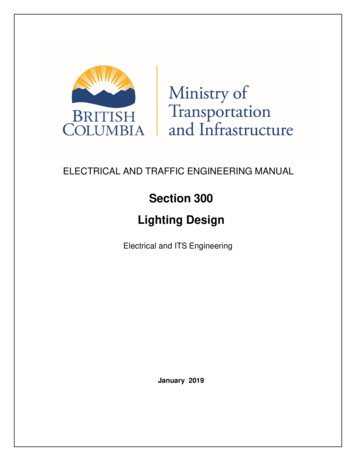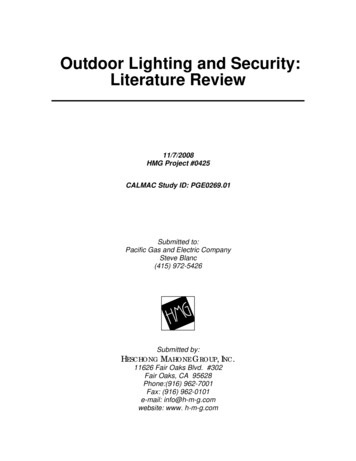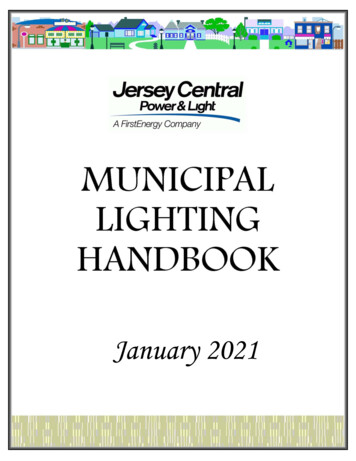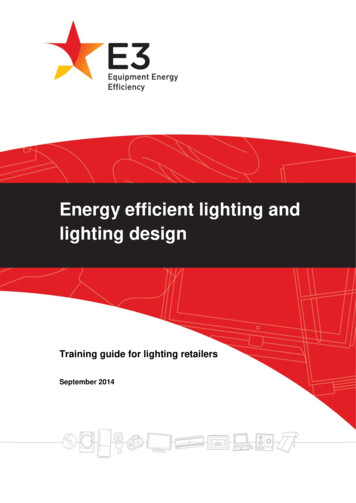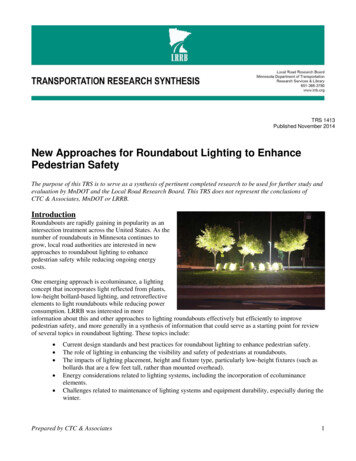
Transcription
TRS 1413Published November 2014New Approaches for Roundabout Lighting to EnhancePedestrian SafetyThe purpose of this TRS is to serve as a synthesis of pertinent completed research to be used for further study andevaluation by MnDOT and the Local Road Research Board. This TRS does not represent the conclusions ofCTC & Associates, MnDOT or LRRB.IntroductionRoundabouts are rapidly gaining in popularity as anintersection treatment across the United States. As thenumber of roundabouts in Minnesota continues togrow, local road authorities are interested in newapproaches to roundabout lighting to enhancepedestrian safety while reducing ongoing energycosts.One emerging approach is ecoluminance, a lightingconcept that incorporates light reflected from plants,low-height bollard-based lighting, and retroreflectiveelements to light roundabouts while reducing powerconsumption. LRRB was interested in moreinformation about this and other approaches to lighting roundabouts effectively but efficiently to improvepedestrian safety, and more generally in a synthesis of information that could serve as a starting point for reviewof several topics in roundabout lighting. These topics include: Current design standards and best practices for roundabout lighting to enhance pedestrian safety.The role of lighting in enhancing the visibility and safety of pedestrians at roundabouts.The impacts of lighting placement, height and fixture type, particularly low-height fixtures (such asbollards that are a few feet tall, rather than mounted overhead).Energy considerations related to lighting systems, including the incorporation of ecoluminanceelements.Challenges related to maintenance of lighting systems and equipment durability, especially during thewinter.Prepared by CTC & Associates1
To gather this information, CTC & Associates conducted a literature search to identify design guidance, researchand best practices. We also conducted interviews with researchers and practitioners who have extensiveexperience in this area.Summary of FindingsWhile many state and local agencies offer guidelines or policies on roundabout design, most of these guides donot offer unique guidelines for lighting but instead cite federal guidance or the Illuminating Engineering Society'sDesign Guide for Roundabout Lighting. The state and local guidelines cited in this report offer additional lightingguidance unique to their own agencies.General PrinciplesNCHRP Report 672: Roundabouts: An Informational Guide (2010) recommends lighting at all roundabouts,although the report acknowledges that lighting may be cost-prohibitive if there is no power supply nearby. Thereport notes that drivers in a roundabout may not expect the geometry and channelization unless it is visible at alltimes, and that the effectiveness of vehicle headlights is reduced because of the curve of the roundabout. Thereport includes recommendations on lighting in potential conflict areas and transition lighting on the approach tothe roundabout.Lighting LevelsWidely cited as the fundamental roundabout lighting standard, the IES Design Guide for Roundabout Lightingmakes recommendations for both horizontal and vertical illuminance levels in a roundabout crosswalk. Theserecommendations vary based on the functional classification of the roads that enter the roundabout and theexpected pedestrian usage of the roundabout; recommended levels range from 8 to 34 lux.A 2008 conference paper from the city of Noblesville, Indiana, outlined several methods for evaluating whether aluminaire layout will effectively meet these recommended illuminance levels. These strategies include obtainingadvice and input from professional design consultants, manufacturers and the power utility, and using computermodeling software or lighting photometric charts to generate illumination contours.Lighting Equipment and LayoutWhile crosswalks are traditionally lit from directly above, recent FHWA guidance and other research recommendpositioning lights ahead of crosswalks in order to improve visibility of pedestrians to drivers. This approachprovides positive contrast for the pedestrians against a darker background. The 2010 MnDOT Roadway LightingDesign Manual recommends placing light poles 1 to 30 feet before the crosswalk and lighting roundabouts fromthe outer edge of the roadway to aid in providing this positive contrast.Illumination can be provided from the interior of the roundabout circle or from its perimeter. NCHRP Report 672notes that the IES Design Guide for Roundabout Lighting recommends perimeter lighting, augmented by lightingon the approach side of crosswalks. The report notes that both lighting options have advantages: Perimeter illumination allows the strongest lighting around critical bicycle and pedestrian areas,provides good visual guidance on the circular roadway, makes approach signs clearly visible andmakes luminaires easier to maintain. Central illumination improves perception of the roundabout at a distance, requires fewer poles toachieve the same illumination, keeps the central pole clear of critical conflict areas, and makes theexit guide signs clearly visible.Roundabouts have several conflict areas where run-off-the-road crashes are most prevalent. The 2014 KansasDOT Roundabout Guide offers detailed guidance about lighting in these areas, recommending that light polesshould be placed as far from the curb as possible.Prepared by CTC & Associates2
Other key guidance includes: MnDOT’s 2010 Roadway Lighting Design Manual recommends illumination on the approach nose ofall splitter islands, at all exit and entry points, and for at least 400 feet along each road that connectsto the roundabout. To improve visibility of the central island and circulating vehicles, lighting theroundabout from the outside in is preferred. The MnDOT Roundabout Lighting Guidelines, which isa separate document offered as a handout, offer more detailed guidance.The FHWA Manual on Uniform Traffic Control Devices notes that the use of post-mounteddelineators and reflective chevrons is common practice for helping drivers recognize the geometry ofa roadway, particularly at curves.Safety Impacts of LightingA forthcoming Georgia DOT study found that roundabout lighting in Minnesota has a safety benefit. (The study isusing crash data from Minnesota, a state with a more established roundabout program, to estimate safety effects inGeorgia.) In the study, which used crash data from 2003 to 2010, Minnesota roundabouts with no illuminationhad an average observed crash rate of 0.458 crashes per million vehicles, compared with 0.285 for roundaboutswith partial illumination and 0.193 for roundabouts with full lighting. This analysis involved only vehiclecollisions and did not evaluate pedestrian safety.Ecoluminance and Energy ConsiderationsEcoluminance is an emerging concept that incorporates multiple features that combine to provide adequateroundabout illumination: lights mounted on bollards (posts typically approximately three to four feet tall) forpedestrian crossings, overhead LED lamps, retroreflective elements, and a central island with landscape lightingand vegetation that can reflect light. Developed by a team at Rensselaer Polytechnic Institute’s Lighting ResearchCenter, this approach focuses on providing luminance (the amount of light reflected or emitted by a surface)rather than illuminance (the amount of light falling on a surface). Several short-term demonstration projects haveused this approach. In these projects, researchers found that this approach provided adequate luminance, andobservers generally felt that the lighting was an improvement compared to conventional overhead lighting.In one study, the relative costs of an ecoluminance-based system compared to one based on high-pressure sodiumoverhead lamps were similar on an annualized basis. These annualized costs factored in initial installation costand annual energy usage. However, the ecoluminance approach uses LED bollards that have high initial costs andlow energy consumption. If LED lamp costs drop as expected, annualized costs for the ecoluminance approachwill also drop.Pedestrian Visibility Under Low-Height LightingResearch on bollard luminaires at crosswalks has concluded that they improve pedestrian visibility. While thetests in these studies took place at mid-block crosswalks or intersections, the researchers expect that the resultswould apply to roundabout crosswalks as well.Winter Maintenance of Low-Height LightingThose we interviewed said that while deicers would likely have minimal impact on bollard fixtures, plowingoperations could impede bollard effectiveness by piling snow in front of them. This could be addressed, at least inexisting roundabouts where traditional lighting is being replaced by low-height lighting, by taking currentplowing operations into consideration when planning the lighting layout, aiming to avoid placing bollards in spotsthat typically get blocked by snow piles.Prepared by CTC & Associates3
Detailed FindingsDefinitionsSeveral technical terms and concepts that are widely used in lighting design appear in this report. The followingdefinitions are adapted from FHWA’s Informational Report on Lighting Design for Midblock Crosswalks unlessotherwise noted (see ty/08053/, pages 2 to 9 and page 14).Illuminance: A measurement of the quantity of light that falls on a surface, measured in lux or footcandles.Vertical illuminance refers to the illuminance on a vertical surface. Vertical illuminance of a pedestrian istypically measured at a point 1.5 meters above the road surface. The mounting height of a luminaire (andtherefore the angle at which the light hits the object) has a significant impact on vertical illuminance.Luminance: A measurement of the quantity of light emitted by a surface, whether directly emitted by an object orreflected by it. Luminance is what an observer perceives, and it is an approximate description of how bright anobject appears. (However, brightness can vary depending on an object’s surroundings; for example, a full moonhas the same luminance during day or night, but appears brighter at night.)Contrast: The visual difference between an object and its background, typically reported as the differencebetween the luminance of the object and the background luminance, divided by the background luminance.Contrast can be negative, which indicates that the object is darker than the background and appears in silhouette.There are two aspects: color contrast, the difference in color between the two, and luminance contrast, thedifference in brightness between the two. Luminance contrast is far more important to pedestrian visibility atnight.Pedestrian visibility: Reported as the distance at which a pedestrian is visible enough for a driver to reactappropriately.Glare: Glare is caused when the luminance of an object is significantly higher than what the human eye isadapted for. There are two types of glare: discomfort glare, which causes discomfort or pain, and disability glare,which actually impedes the ability of the observer to perform a visual task (such as detecting pedestrians).Uniformity: As described in the Kansas Roundabout Guide, uniformity is the ratio of the average illuminance tothe minimum illuminance in a roundabout. (See page 8-2 /burtrafficeng/Roundabouts/Roundabout ard: A bollard is a short vertical post, which can be used in transportation to direct or control traffic, andwhich may or may not include a light installed.Lux and Footcandles: Two measurements of light levels. One lux is equal to one lumen (a measure of the totalamount of visible light emitted by a source) per square meter. According to Wikipedia, a night illuminated by afull moon is 0.27 to 1.0 lux, twilight is at least 3.4 lux, and a home living room is typically about 50 lux. Onefootcandle is equal to approximately 10.8 lux.Key Guidance Documents and ResearchThrough our research and interviews, we identified two key national guidance documents that address roundaboutlighting, as well as four documents from state DOTs and local agencies. This section lists these six documents forreference. Detailed guidance from each document is included in the appropriate sections of this report.Prepared by CTC & Associates4
National Guidance and ResourcesDesign Guide for Roundabout Lighting, Illuminating Engineering Society, 2008.Summary at roundabout-lighting-1037.cfmThis guide is widely cited as the fundamental roundabout lighting standard. NCHRP Report 672 describes it as“the primary resource that should be consulted in completing a lighting plan for a roundabout.” MnDOT’sRoadway Lighting Design Manual uses the guide’s recommended lighting values.NCHRP Report 672: Roundabouts: An Informational Guide, Second Edition, Lee Rodegerdts, Justin Bansen,Christopher Tiesler, Julia Knudsen, Edward Myers, Mark Johnson, Michael Moule, Bhagwant Persaud, CraigLyon, R. Barry Crown, Bernard Guichet and Andrew O’Brien, hrp rpt 672.pdfIn addition, three FHWA guidance documents are referenced in specific sections of this report: Informational Report on Lighting Design for Midblock Crosswalks, 2008. Technical Summary on Mini-Roundabouts, 2010. Manual on Uniform Traffic Control Devices, 2009 with 2012 updates.State and Local Guidance and ResourcesWe identified guidance and research on roundabout lighting from four agencies: Minnesota DOT; Kansas DOT;the city of Bend, Oregon; and the city of Noblesville, Indiana.Minnesota DOTMnDOT Roadway Lighting Design Manual, May g/2010 Roadway Lighting Design Manual2.pdf MnDOT Roundabout Lighting Guidelines (see Appendix A)Kansas DOTKansas Roundabout Guide, Second Edition, Kittelson & Associates, aus/burtrafficeng/Roundabouts/Roundabout us version of the guide:Kansas Roundabout Guide, Kittelson & Associates, rces/fhwasa09027/resources/Kansas Roundabout Guide.pdfBend, OregonCity of Bend Roundabout Evaluation and Design Guidelines, Kittelson & Associates, April .aspx?documentid 2512Noblesville, Indiana“Developing Effective Standards and Strategies for Roundabout Lighting,” John Beery and AndrewRodewald, City of Noblesville, Indiana, Institute of Transportation Engineers Annual Conference, August 2008/AB08H0202.pdfPrepared by CTC & Associates5
Roundabout Lighting Standards and Best PracticesGeneral PrinciplesNCHRP Report 672: Roundabouts: An Informational Guide, Second Edition, hrp rpt 672.pdfChapter 8 of NCHRP Report 672 defines the primary purposes of roundabout lighting as providing visibility forusers approaching the roundabout and providing visibility of key conflict areas to help users see other users in theroundabout. It notes that drivers in a roundabout may not expect the geometry and channelization unless it isvisible at all times, and that the effectiveness of vehicle headlights is reduced because of the curve of theroundabout. The report recommends lighting at all roundabouts, although it acknowledges that lighting may becost-prohibitive if there is no power supply nearby.The report makes several general recommendations regarding roundabout lighting design: Overall roundabout illumination should be approximately equal to the sum of the illumination levelsof the intersecting roadways. Lighting design should include transition lighting that extends along the approach to the roundabout ifcontinuous roadway lighting is not present. This allows drivers’ vision to adjust from the litroundabout back to the dark roadway. Adequate illumination should be provided on the approach nose of roundabout splitter islands, atevery location where traffic enters the roundabout and could conflict with traffic already in theroundabout, and at every location where traffic streams separate (roundabout exits). Adequate illumination should be provided for pedestrian crossing and bicycle merging areas. The impact of the lighting on adjacent properties and ambient lighting zones should be considered.Efforts should be made to minimize glare and misdirected light. Raised channelization and curbing should be illuminated.Lighting LevelsDesign Guide for Roundabout Lighting, Illuminating Engineering Society, 2008.Summary at roundabout-lighting-1037.cfmAs reported in NCHRP Report 672 (Section 8.3), the Design Guide for Roundabout Lighting makesrecommendations for the average horizontal illuminance on the pavement based on the functional classificationsof the roads (major, collector or local) that enter the roundabout and the expected pedestrian usage of theroundabout during the average annual peak hour of darkness (typically 6 to 7 p.m.). These recommendations varyfrom 8 to 34 lux. The standards specify that vertical luminance in the crosswalk should be equal to thesehorizontal illuminance levels. Finally, the standards also specify uniformity based on road classification, rangingfrom 3:1 to 6:1.Additional resource:Technical Summary on Mini-Roundabouts, FHWA, L.A. Rodegerdts, W.E. Scarbrough, J.A. Bansen,February abouts/fhwasa10007/fhwasa10007.pdfThis FHWA Technical Summary on mini-roundabouts states that the principles outlined in the IESDesign Guide for Roundabout Lighting apply to mini-roundabouts.MnDOT Roadway Lighting Design Manual, May g/2010 Roadway Lighting Design Manual2.pdfIn addition to using the IES lighting level recommendations, MnDOT’s Roadway Lighting Design Manual(Section 1.4.9) suggests that light intensity of a roundabout should be 1 footcandle (10 lux) greater than betweenPrepared by CTC & Associates6
intersections where there is continuous lighting, or double the light intensity if there is low illumination betweenintersections.“Developing Effective Standards and Strategies for Roundabout Lighting,” John Beery and AndrewRodewald, City of Noblesville, Indiana, Institute of Transportation Engineers Annual Conference, August 2008/AB08H0202.pdfWhile many agencies’ guidelines reference the IES recommended illuminance values for intersections, this paperby City of Noblesville staff offers additional guidance, outlining several methods for evaluating whether aluminaire layout will effectively meet these recommended illuminance levels. These methods include: Obtaining advice from a professional design consultant.Considering manufacturers’ recommendations and input.Obtaining advice from the power utility providing the lighting.Using computer modeling software to produce illumination contour intervals.Manually generating illumination contours using lighting photometric charts.City of Bend Roundabout Evaluation and Design Guidelines, Kittelson & Associates, April .aspx?documentid 2512While the city recommends using the IES guidelines for illumination, its guidelines also specify a minimumhorizontal illumination of 1.0 footcandles (10 lux) and a uniformity of 3:1 or better (see page 12). The guidelinesalso note that recent studies recognize the importance of vertical illuminance, and recommend that it meet thesame minimum standard as horizontal illuminance.We spoke with city Transportation Engineer Robin Lewis, who said the city ensures that the noses of short splitterislands are well lit if they are present. Lewis said bike and pedestrian conflict areas are also areas of focus. Thecity tries to light in advance of pedestrian crossings so pedestrians in the crossings are well lit.FHWA Lighting Handbook, Paul Lutkevich, Don McLean, Joseph Cheung, August 2012.http://safety.fhwa.dot.gov/roadway dept/night visib/lighting handbook/This handbook specifically recommends against the use of adaptive lighting, which allows the lighting level to bereduced during off-peak hours, in roundabouts because of their geometry and the effectiveness of fixed headlightswithin the roundabout circle.Additional ResourcesWe interviewed Bastian Schroeder, assistant director of highway systems at the Institute for TransportationResearch and Education (housed at North Carolina State University), who has published research on many aspectsof roundabouts. Regarding lighting levels, Schroeder suggested that the principles outlined in FHWA’sInformational Report on Lighting Design for Midblock Crosswalks would be applicable to roundabout pedestriancrossings as well.For studies on pedestrian visibility in crosswalks using low-height bollard lighting, see “Pedestrian VisibilityUnder Low-Height Lighting” on page 17 of this report.Informational Report on Lighting Design for Midblock Crosswalks, FHWA, Ronald B. Gibbons, ChrisEdwards, Brian Williams and Carl K. Anderson, April /safety/08053/This report recommends a vertical illuminance of 20 lux in crosswalks at a height of 1.5 meters. This lightingshould extend the entire width of the roadway to ensure that pedestrians are visible before they step into theroadway.Prepared by CTC & Associates7
The report describes the importance of both luminaire height and angle in achieving the necessary illuminance.Using a vertical illuminance plot, the report demonstrates that a 250-watt high-pressure sodium luminairemounted at a height of 8.5 meters will produce a vertical illuminance of 20 lux at a (horizontal) distance of 4.25 to6 meters from the luminaire. Mounting height has a significant impact on vertical illuminance; the same luminairemounted at a height of 10 meters will never produce a vertical illuminance of 20 lux at pedestrian height.Similarly, while many agencies traditionally light crosswalks from directly above, the report recommends lightingthem from ahead of the crosswalk to make pedestrians more visible.Lighting Equipment and LayoutNCHRP Report 672: Roundabouts: An Informational Guide, Second Edition, hrp rpt 672.pdfChapter 8 of this report describes common lighting equipment types, including cobra-style, ornamental and highmast lighting, but suggests that agency staff select equipment based on the needs of a specific roundabout.The report discusses pole location options including lighting in the central island or around the perimeter of theroundabout, noting that the IES Design Guide for Roundabout Lighting recommends perimeter lighting,augmented by lighting on the approach side of crosswalks. Both options have advantages and disadvantages.Perimeter illumination allows the strongest lighting around critical bicycle and pedestrian areas, provides goodvisual guidance on the circular roadway, makes approach signs clearly visible and makes luminaires easier tomaintain. Central illumination improves perception of the roundabout at a distance, requires fewer poles toachieve the same illumination, keeps the central pole clear of critical conflict areas, and makes the exit guide signsclearly visible.MnDOT Roadway Lighting Design Manual, May g/2010 Roadway Lighting Design Manual2.pdfSection 1.4.9 of MnDOT’s Roadway Lighting Design Manual cites NCHRP Report 672’s guidance onroundabout lighting. Additionally, for pedestrian lighting at roundabouts, it states: “Crosswalks at roundaboutsshould typically be lit with the pedestrians in positive contrast. Light poles placed 1 to 30 feet before thecrosswalk [are] recommended for this purpose. Roundabouts should be lit from the outer edge of the roadway toaid in providing this positive contrast to pedestrians.”The manual recommends illumination on the approach nose of all splitter islands, at all areas where traffic entersor exits the circulation stream of the roundabout, and for at least 400 feet along each road that connects to theroundabout. It also states: “It is preferable to light the roundabout from the outside in towards the center. Thisimproves the visibility of the central island and the visibility of circulating vehicles to vehicles approaching theroundabout.”The MnDOT Roundabout Lighting Guidelines (included as Appendix A to this TRS), which are a separatedocument from the MnDOT Roadway Lighting Design Manual but offered as a handout accompanying it, specifythat roundabouts should be illuminated in all urban conditions, and in suburban conditions when one or moreapproaches are lit, when competing (non-roadway) illumination in the vicinity could distract drivers, when heavynighttime traffic is expected, or when pedestrian or bicycle traffic is expected. In rural conditions, illumination isrecommended but allowances for enhanced signing and markings are allowed if illumination is impossible.The Roundabout Lighting Guidelines specify at least 8 light poles in a 4-leg roundabout: 1 light in advance of thecrosswalk at each approach and exit in order to provide positive contrast lighting for pedestrians and yieldedvehicles. Additional light poles may be needed when there are high-speed approaches or sight constraints, and inrural conditions. While lighting should extend at least 400 feet along each road connected to the roundabout,transition lighting can be used to help drivers adjust their vision back to dark conditions. If transition lighting isused, full lighting should begin 250 feet from the roundabout.Prepared by CTC & Associates8
In clear zones, light pole locations relative to curbs are governed by the potential speeds of vehicles that run offthe road; the document recommends referring to the AASHTO Roadside Design Guide and the ANSI/IESNAAmerican National Standard Practice for Roadway Lighting for details. Specific practices to avoid includeplacing poles in splitter islands, placing poles on the right-hand perimeter just downstream of an exit point, andlighting from the central island outward.“Developing Effective Standards and Strategies for Roundabout Lighting,” City of Noblesville, Indiana,Institute of Transportation Engineers Annual Conference, August 2008/AB08H0202.pdfIn this paper, staff detail the city’s process for establishing standards and policies for roundabout lighting, notingthat “traditional and conventional methods for luminaire spacing and placement along linear roadways do notaddress the need to illuminate critical areas associated with the unique geometrics of roundabouts.”For pedestrian crossings, the paper recommends initially planning to place luminaires approximately 10 feetahead of the crossing in both entry and exit lanes (see page 8 of the paper). The authors acknowledge, however,that lighting or infrastructure needs may require the luminaire placement to be adjusted. The paper alsoencourages designers to anticipate future crosswalk locations through splitter islands at roundabouts that aredesigned without crosswalks, and to use this planning to determine light placement. If this is not feasible, theauthors recommend placement of the first street light at least 75 feet or three car lengths in advance of the innercircle.The paper notes that lighting fixture selection is one of the most important aspects of effective roundaboutlighting. “It cannot be over-emphasized that implementing effective illumination begins with understanding thetype of luminaire used for the desired application,” the authors write. “The most common error when consideringthe installation of street lighting is selecting a luminaire and pole based solely on aesthetics.” The paper provideslighting contours for four luminaire types: decorative structural cut-off, old-English-style decorative non-cut-off,traditional cobra head and post-top decorative.The authors recommend against placing light poles in splitter islands due to safety concerns, particularly inroundabouts that have mountable curbs to permit large trucks to turn. All light locations should be analyzed toensure that they will not be affected by vehicle turning movements, and poles placed in the clear zone should beinstalled with breakaway transformer bases or breakaway foundation bolts for safety.Kansas Roundabout Guide, Second Edition, Kittelson &Associates, aus/burtrafficeng/Roundabouts/Roundabout Guide/KansasRoundaboutGuideSecondEdition.pdfThe guide offers detailed guidance about the critical conflictareas in a roundabout where run-off-the-road crashes are mostprevalent (see Figure 1, from page 8-4 of the guide). Lightpoles in these areas, which include the outer curves of theroundabout, the medians between the approach and exit lanesand most of the central island, should be placed as far awayfrom the curb as practical.The guide states: “In rural areas, KDOT prefers locating lightpoles at least 2 feet from the edge of the shoulder, or at least 8feet from the edge of the pavement in the absence of ashoulder.” In urban areas, the guide recommends poles be atleast 6 to 8 feet behind the curb, and it specifies a minimumPrepared by CTC & AssociatesFigure 1: Conflict areas where run‐off‐the‐roadcrashes are most common (from the KansasRoundabout Guide, Second Edition).9
offset distance of 3 feet for areas in or approaching the roundabout where the overhang of a turning truck could hita pole.The first edition of the Kansas Roundabout urces/fhwasa09027/resources/Kansas Roundabout Guide.pdf)pro
Design Guide for Roundabout Lighting. The state and local guidelines cited in this report offer additional lighting guidance unique to their own agencies. General Principles NCHRP Report 672: Roundabouts: An Informational Guide (2010)

